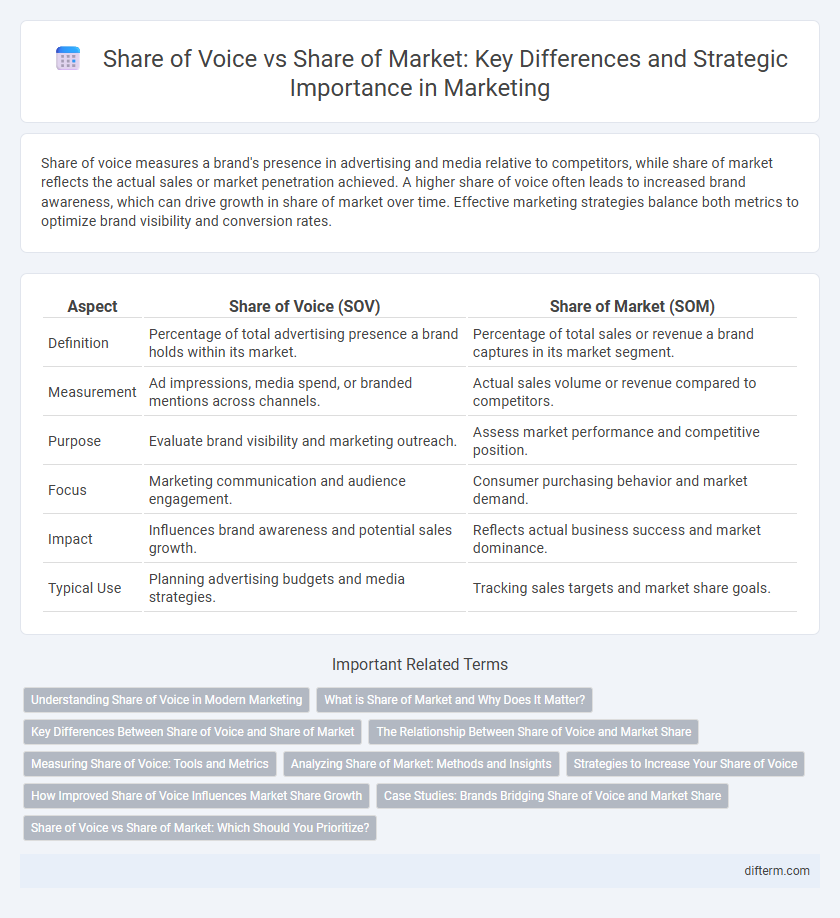Share of voice measures a brand's presence in advertising and media relative to competitors, while share of market reflects the actual sales or market penetration achieved. A higher share of voice often leads to increased brand awareness, which can drive growth in share of market over time. Effective marketing strategies balance both metrics to optimize brand visibility and conversion rates.
Table of Comparison
| Aspect | Share of Voice (SOV) | Share of Market (SOM) |
|---|---|---|
| Definition | Percentage of total advertising presence a brand holds within its market. | Percentage of total sales or revenue a brand captures in its market segment. |
| Measurement | Ad impressions, media spend, or branded mentions across channels. | Actual sales volume or revenue compared to competitors. |
| Purpose | Evaluate brand visibility and marketing outreach. | Assess market performance and competitive position. |
| Focus | Marketing communication and audience engagement. | Consumer purchasing behavior and market demand. |
| Impact | Influences brand awareness and potential sales growth. | Reflects actual business success and market dominance. |
| Typical Use | Planning advertising budgets and media strategies. | Tracking sales targets and market share goals. |
Understanding Share of Voice in Modern Marketing
Share of Voice (SOV) measures a brand's presence and visibility in advertising channels compared to competitors, reflecting its prominence in consumer conversations and media spaces. Understanding Share of Voice enables marketers to gauge the effectiveness of their campaigns and allocate budgets strategically to increase brand awareness. High SOV often correlates with increased Share of Market (SOM), highlighting the importance of consistent and impactful messaging across digital and traditional marketing platforms.
What is Share of Market and Why Does It Matter?
Share of Market (SOM) represents the percentage of total sales a company captures within its industry, reflecting its competitive position and market dominance. Measuring SOM is crucial for identifying growth opportunities, allocating marketing budgets efficiently, and benchmarking performance against competitors. Understanding Share of Market helps businesses strategize product development, pricing, and distribution to increase revenue and customer acquisition.
Key Differences Between Share of Voice and Share of Market
Share of voice measures a brand's advertising presence and visibility compared to competitors within a specific market, while share of market quantifies a brand's actual sales or revenue percentage in that market. The key difference lies in share of voice reflecting marketing effort and audience reach, whereas share of market demonstrates tangible consumer purchase behavior and market dominance. Understanding both metrics enables marketers to align advertising strategies with business performance and optimize growth opportunities.
The Relationship Between Share of Voice and Market Share
Share of voice (SOV) measures a brand's advertising presence relative to competitors, while market share (MS) reflects the actual sales volume within a market. Higher SOV often drives increased brand awareness, which can lead to accelerated growth in market share, especially when a brand's SOV exceeds its current MS, a phenomenon known as SOV surplus. Marketing studies indicate maintaining an SOV above market share by 10-20% correlates with significant improvements in market penetration and revenue growth.
Measuring Share of Voice: Tools and Metrics
Measuring Share of Voice (SOV) involves analyzing brand visibility across multiple channels using tools like brand monitoring software, social listening platforms, and media analytics. Key metrics include mentions, impressions, engagement rates, and advertising spend relative to competitors, providing insights into a brand's presence compared to its market share. Accurate SOV measurement helps optimize marketing strategies by quantifying brand exposure and identifying opportunities to increase market influence.
Analyzing Share of Market: Methods and Insights
Analyzing Share of Market involves measuring a brand's sales volume relative to the total industry sales within a specific period, typically calculated through market research and sales data analysis. Methods to assess Share of Market include tracking sales revenue, unit sales, and customer segments to identify competitive positioning and growth opportunities. Insights gained from Share of Market analysis help marketers allocate resources efficiently, optimize pricing strategies, and tailor marketing campaigns to increase market penetration and drive revenue growth.
Strategies to Increase Your Share of Voice
Increasing your share of voice involves amplifying brand visibility through targeted advertising, content marketing, and social media engagement, which directly influences consumer perception and preference. Leveraging data-driven insights to optimize campaign frequency and message relevance ensures a consistent presence in the competitive landscape. Prioritizing influencer partnerships and interactive content can further enhance audience connection, ultimately converting increased share of voice into greater market share.
How Improved Share of Voice Influences Market Share Growth
Improved Share of Voice (SOV) enhances brand visibility by increasing the percentage of advertising impressions a brand receives compared to competitors, driving higher consumer awareness. As SOV rises above a brand's current Market Share (SOM), the likelihood of converting potential customers grows, accelerating Market Share growth in competitive industries. Data from marketing analytics consistently shows that brands maintaining a SOV greater than their SOM experience faster market penetration and sustained revenue gains.
Case Studies: Brands Bridging Share of Voice and Market Share
Brands that successfully bridge share of voice and market share often deploy integrated marketing campaigns emphasizing consistent messaging across digital and traditional channels. Case studies reveal that companies like Coca-Cola and Apple leverage high share of voice through targeted advertising and influencer partnerships, which correlates with sustained or growing market share. These strategic alignments enhance brand visibility and consumer engagement, driving measurable increases in sales performance.
Share of Voice vs Share of Market: Which Should You Prioritize?
Share of Voice (SOV) measures your brand's advertising presence relative to competitors, while Share of Market (SOM) reflects the actual percentage of sales your brand holds in the market. Prioritizing SOV can drive increased brand awareness and influence consumer preference, often leading to future growth in SOM. Marketing strategies focused on boosting SOV tend to generate long-term market share gains by amplifying brand visibility and engagement.
Share of voice vs share of market Infographic

 difterm.com
difterm.com